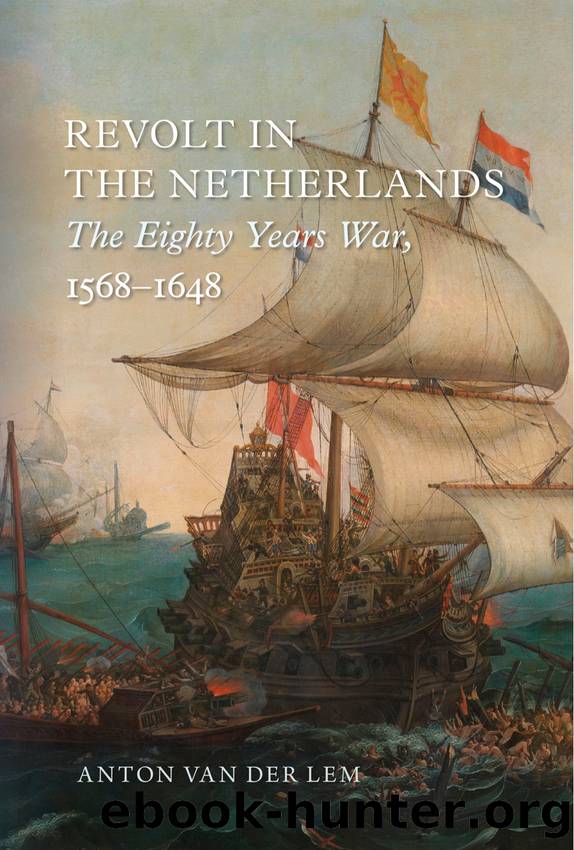Revolt in the Netherlands by Anton van Der Lem

Author:Anton van Der Lem
Language: eng
Format: epub
Publisher: Reaktion Books
54 The capture of Grave by Parma. Note the river closed off at E.
The Crucial âTen Yearsâ: The âGarden of Hollandâ Closed
Once again, developments abroad were to affect the situation in the Netherlands. The unpredictable French king Henri III, who had been offered sovereignty of the Low Countries, had had Catholic leaders the Duke of Guise and his brother the Cardinal of Guise murdered, on 23 and 24 (Christmas Eve!) December 1588.15 On 1 August 1589, King Henri himself fell victim to an assassin. Philip II felt compelled to order Parma and his armies to Paris to prevent the city and country falling into the hands of the Protestant successor to the throne, Henri of Navarre. A Protestant king in France, after already having had to acknowledge a Protestant queen in England, was too much for Philip. When he became king, Philip had been compared to King Solomon, whose father David had also still been alive when he was succeeded by his son. Philipâs nickname, el Prudente, was therefore first taken to mean âthe Wiseâ, by analogy with Solomon, but this was later translated as âthe Prudentâ. Philip was certainly very prudent in the early years of his reign. Later, however, he was determined to be the champion of the Catholic faith at any price, not only in his own domains but also in the international arena. By then, he had thrown all prudence to the wind and devoted all his military and financial resources to defending the faith.16 Although Parma had advised the king first to defeat all the remaining rebellious provinces in the Netherlands now that he was making such good progress, thwarting the danger of a Protestant France was much more important to Philip. On the kingâs orders, Parma conducted two successful expeditions against France and on 19 September 1590 entered Paris. That gave the rebels above the major rivers in the Low Countries an opportunity they could not afford to ignore.
In his classic study Tien jaren uit de Tachtigjarige Oorlog (Ten Years from the Eighty Years War), first published in 1857, Robert Fruin gave a proud and still breathtaking account of the history of the young Republic from 1588 to 1598.17 He strongly emphasized the independence and enterprising spirit of the still small Union. But he also stressed that, without Parma being tied up in France, such a success would never have been possible. In 1588, Maurice was stadtholder of Holland and Zeeland, and in the years that followed he also became stadtholder of Utrecht, Gelderland and Overijssel. His cousin William Louis had already been Orangeâs deputy as stadtholder in Friesland and had succeeded him after his death. William Louis preceded Maurice in studying classical warfare, as was customary in Europe at that time. Both continued the reorganization and professionalization of the army of the States, which Orange had initiated. Both also continually favoured an offensive war as the best form of defence. In 1589, William Louis had passionately argued at a meeting of the States
Download
This site does not store any files on its server. We only index and link to content provided by other sites. Please contact the content providers to delete copyright contents if any and email us, we'll remove relevant links or contents immediately.
| Africa | Americas |
| Arctic & Antarctica | Asia |
| Australia & Oceania | Europe |
| Middle East | Russia |
| United States | World |
| Ancient Civilizations | Military |
| Historical Study & Educational Resources |
Magic and Divination in Early Islam by Emilie Savage-Smith;(1500)
Ambition and Desire: The Dangerous Life of Josephine Bonaparte by Kate Williams(1345)
Bohemians, Bootleggers, Flappers, and Swells: The Best of Early Vanity Fair by Bohemians Bootleggers Flappers & Swells- The Best of Early Vanity Fair (epub)(1343)
Papillon by Henry Charrière(1310)
Twelve Caesars by Mary Beard(1256)
Operation Vengeance: The Astonishing Aerial Ambush That Changed World War II by Dan Hampton(1136)
What Really Happened: The Death of Hitler by Robert J. Hutchinson(1129)
London in the Twentieth Century by Jerry White(1114)
Time of the Magicians by Wolfram Eilenberger(1089)
The Japanese by Christopher Harding(1086)
Twilight of the Gods by Ian W. Toll(1084)
Lenin: A Biography by Robert Service(1045)
The Devil You Know by Charles M. Blow(985)
A Social History of the Media by Peter Burke & Peter Burke(936)
Freemasons for Dummies by Hodapp Christopher;(922)
Napolean Hill Collection by Napoleon Hill(902)
Henry III by David Carpenter;(891)
The Churchill Complex by Ian Buruma(882)
The Rise and Triumph of the Modern Self by Unknown(879)
